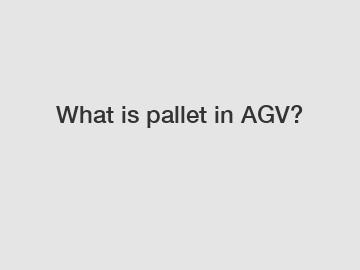What is pallet in AGV?
In the ever-evolving world of automation, one technology that has gained significant traction is Automated Guided Vehicles (AGVs). These intelligent machines have revolutionized material handling across various industries, enhancing efficiency, reducing costs, and ensuring a streamlined workflow. In this blog, we delve deep into AGVs and shed light on an integral component of their functioning – the pallet.
The Importance of AGVs in Material Handling:
AGVs are sophisticated robotic vehicles designed to transport materials and goods autonomously. They navigate through a facility using a variety of sensors and predefined maps, eliminating the need for human intervention. With their ability to perform repetitive tasks reliably and efficiently, AGVs have become a game-changer in material handling operations.

Understanding Pallets:
A pallet is a flat transport structure that serves as a base for storing and carrying goods. It provides a stable platform for the AGV to safely move and manipulate objects. Pallets come in different shapes, sizes, and materials, catering to diverse industry requirements. They are typically constructed from wood, plastic, or metal, offering durability and strength to withstand heavy loads.
How Pallets Facilitate AGV Operations:
1. Load Carrying: Pallets serve as the foundation for efficiently transporting goods, allowing AGVs to move items swiftly and safely within a facility. The pallet's flat surface provides stability and prevents damage to the transported products, reducing the risk of accidents or breakages.
2. Consistency and Standardization: By adhering to standard pallet sizes and specifications, a uniform system is established, allowing AGVs to seamlessly interact with palletized goods during loading and unloading processes. This standardization streamlines operations and enables AGVs to work efficiently across different areas and industries.
3. Compatibility with Automation: AGVs are programmed to work in harmony with palletized goods. The pallet's design and features, such as slots or handles, enable AGVs to effortlessly lift and transport them. Additionally, pallets are often equipped with identification markers, such as barcode stickers or RFID tags, facilitating easy tracking, inventory management, and seamless integration with warehouse management systems.
4. Flexibility and Adaptability: Pallets are not limited to a single industry or application. They offer versatility, allowing AGVs to handle various types of goods, including boxes, crates, cartons, or even individual items placed on pallets. This adaptability makes AGVs compatible with multiple production processes, further enhancing their potential for industries seeking automation solutions.
Challenges and Solutions:
While palletized goods greatly enhance AGV operations, there are a few challenges that should be addressed:
1. Non-Standardized Pallets: Some industries may use non-standard or custom-built pallets due to specific product requirements. AGVs would need adaptations or additional attachments to handle such pallets, increasing complexity and costs.
2. Pallet Stability: Ensuring adequate stability of goods on pallets during AGV transportation is crucial. Implementing securing mechanisms like straps, nets, or load-stops can minimize the risks of displacement or accidents during transit.
3. Pallet Damage: AGVs must be programmed to handle pallets with care to prevent damage, especially when stacking or unstacking items. Incorporating sensors and algorithms that account for fragile or delicate goods can further mitigate risks.
Maximizing AGV Efficiency:
To fully harness the potential of AGVs, businesses can employ strategies to optimize their operations involving pallets:
1. Standardization: Adopting industry-standard pallet sizes and designs can ensure smooth integration with AGVs, minimizing the need for modifications or special adaptations.
2. Load Optimization: AGV routing algorithms can be adapted to optimize the palletized goods' arrangement, reducing idle travel time and maximizing productivity during transportation.
Conclusion:
In summary, pallets play a pivotal role in the seamless functioning of Automated Guided Vehicles (AGVs). By providing stability, compatibility with automation systems, and a standardized platform for goods transportation, pallets enhance AGV efficiency, productivity, and safety. As industries continue to explore automation possibilities, understanding the significance of pallets in AGV operations becomes essential for unlocking the true potential of these groundbreaking technologies.
For more information, please visit 2.5 Ton Full Directional Electric Forklift, Full Directional Forklift, Customized Pallet Truck.

Comments
0